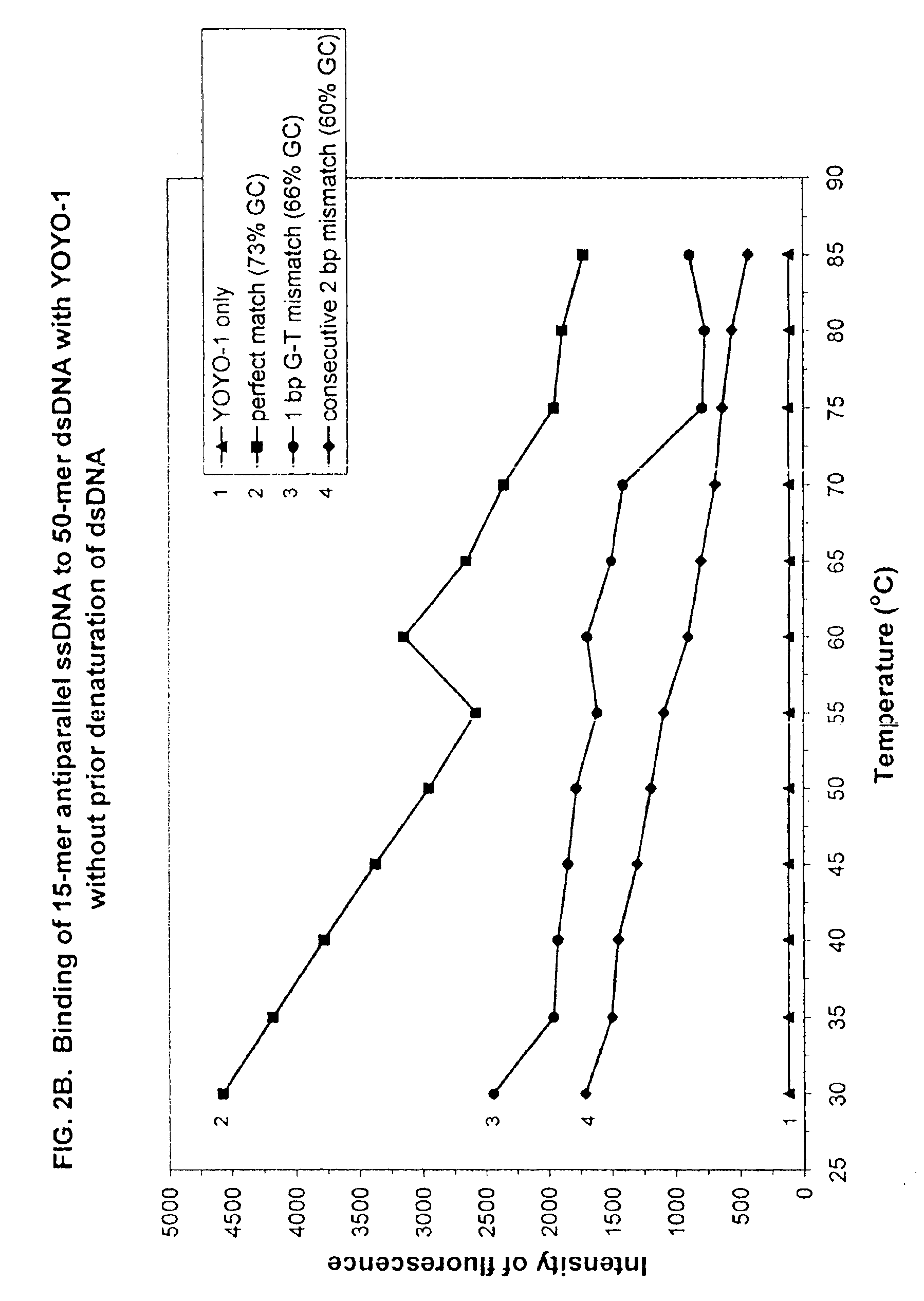Nucleic acid multiplex formation
a technology of nucleic acid and multiplexes, applied in the field of nucleic acid multiplexes, can solve the problems of complexes relying on hoogstein-type polymers that are limited to structures, the full potential of quadruplex nucleic acid has not been fully appreciated or fully exploited, and the work is not done in full
- Summary
- Abstract
- Description
- Claims
- Application Information
AI Technical Summary
Benefits of technology
Problems solved by technology
Method used
Image
Examples
example 1
[0345]Example 1 demonstrates that the assay of the invention can discriminate between perfectly complementary dsDNA:ssDNA complexes and dsDNA:ssDNA complexes containing 1 bp, 2 bp and 3 bp mismatches or deletions when a cationic DNA intercalator, YOYO-1 (Molecular Probes, Eugene, Oreg., USA), is present. NMR spectroscopic analyses of the mechanism of interaction between YOYO-1 and dsDNA have shown that the intercalation of YOYO-1 results in a localized decondensation of the dsDNA helix by 106° generating an overall helical repeat of 13 base pairs as opposed to the normal 10 base pair helical repeat in non-condensed B conformation dsDNA [J. Biomolec. Struct. and Dynamics 16, 205-222 (1998)].
[0346]Complementary sense and antisense 50-mer ssDNA target sequences, derived from exon 10 of the human cystic fibrosis gene [Nature 380, 207 (1996)] were synthesized on a DNA synthesizer (Expedite 8909, PerSeptive Biosystems) and purified by HPLC. Equimolar amounts of the complementary oligonucl...
example 2
[0378]To ensure that the fluorescent intensity assay using a DNA decondensing agent, ssDNA probes and non-denatured dsDNA targets, would apply to probe and target DNAs possessing dramatically different percent GC contents (and potentially different annealing temperatures), new 15-mer ssDNA probes and 50-mer dsDNA target sequences were synthesized, purified and annealed as above. Both ssDNA probes and dsDNA targets were dissolved in ddH2O at a concentration of 1 pmole / μl.
[0379]SEQ ID NO:6 was a 50-mer dsDNA target sequence modified from SEQ ID NO:1, wherein the percent GC content was changed from 30% to 52%.
[0380]Sequence for the sense strand of the wild-type target DNA (SEQ ID NO:6) was:
[0381]
5′-GAG CAC CAT GAC AGA CAC TGT CAT CTC TGG TGT GTCCTA CGA TGA CTC TG-3′
[0382]Sequence for the antisense strand of the wild-type target DNA (SEQ ID NO:6) was:
[0383]
5′-CAG AGT CAT CGT AGG ACA CAC CAG AGA TGA CAG TGTCTG TCA TGG TGC TC-3′
[0384]SEQ ID NO:7 was a 50-mer mutant dsDNA target sequence i...
example 3
[0439]The next examples will demonstrate the specificity of the assay utilizing different DNA condensing agents to promote and stabilize complex formation with non-denatured dsDNA targets and ssDNA-F probes.
[0440]Probe No. 4 was a 15-mer antiparallel ssDNA probe identical to Probe No. 1 except it had an attached fluorescein moiety at the 5′ position. Probe No. 4 was synthesized on a DNA synthesizer, purified by HPLC, and dissolved in ddH2O at a concentration of 1 pmole / μl.
[0441]Sequence for Probe No. 4 was:
[0442]
5′-Flu-CAC CAA AGA TGA TAT-3′
[0443]The hybridization reaction mixture (40 μl) contained the following: 0.4 pmoles of target dsDNA, 4 pmoles of 5′-fluorescein labeled ssDNA Probe No. 4, 10 mM Tris-HCl, pH 7.5, and 10 mM to 125 mM NaCl. The reaction mixtures were incubated at room temperature (21° C.) for 1 hour, without prior denaturation of dsDNA targets. Samples were placed into a quartz cuvette, irradiated with an argon ion laser beam having a wavelength of 488 nm and moni...
PUM
| Property | Measurement | Unit |
|---|---|---|
| Temperature | aaaaa | aaaaa |
| Temperature | aaaaa | aaaaa |
| Fraction | aaaaa | aaaaa |
Abstract
Description
Claims
Application Information
 Login to View More
Login to View More - R&D
- Intellectual Property
- Life Sciences
- Materials
- Tech Scout
- Unparalleled Data Quality
- Higher Quality Content
- 60% Fewer Hallucinations
Browse by: Latest US Patents, China's latest patents, Technical Efficacy Thesaurus, Application Domain, Technology Topic, Popular Technical Reports.
© 2025 PatSnap. All rights reserved.Legal|Privacy policy|Modern Slavery Act Transparency Statement|Sitemap|About US| Contact US: help@patsnap.com



